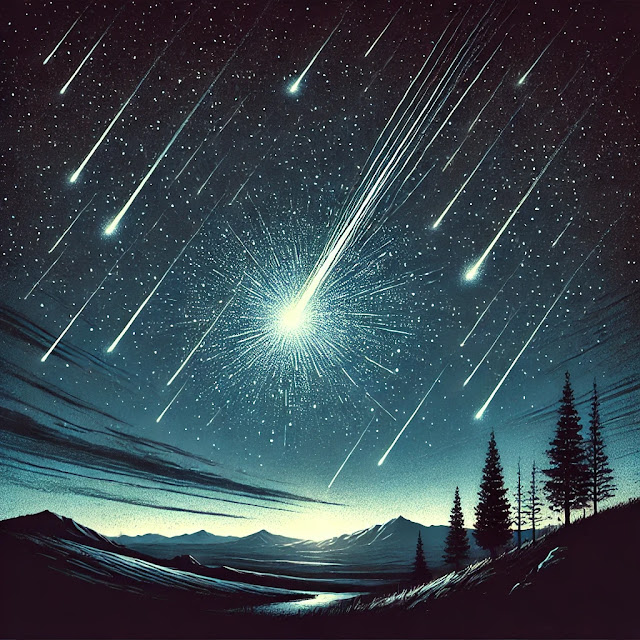The Perseid Meteor Shower: A Spectacular Celestial Event
Introduction
The Perseid meteor shower is one of the most anticipated celestial events of the year, captivating skywatchers around the world with its dazzling display of shooting stars. Occurring annually between mid-July and late August, the Perseid meteor shower reaches its peak around August 11th to 13th, when hundreds of meteors streak across the night sky. This year, the Perseids have once again lit up the heavens, providing a stunning show that has thrilled both amateur astronomers and casual stargazers alike.
What is the Perseid Meteor Shower?
The Perseid meteor shower is an annual event caused by Earth passing through the debris trail left by the comet Swift-Tuttle. This comet, which orbits the Sun once every 133 years, leaves behind a trail of dust and small particles. As Earth moves through this debris field, these particles enter our atmosphere at high speeds—up to 59 kilometers per second—creating bright streaks of light as they burn up.
The Perseids are named after the constellation Perseus, from which they appear to radiate. The shower is known for its high activity rate, often producing between 50 and 100 meteors per hour at its peak under ideal viewing conditions. The Perseids are also famous for producing bright fireballs, which are larger explosions of light and color that can last longer than an average meteor streak.
Recent News and Observations
The Perseid meteor shower of 2024 has been particularly spectacular, with clear skies and favorable viewing conditions reported across much of the Northern Hemisphere. According to NASA, this year’s shower has been one of the best in recent years, with peak viewing occurring on the nights of August 12th and 13th.
Skywatchers from various parts of the world, including North America, Europe, and parts of Asia, have reported seeing up to 60-70 meteors per hour during the peak. In rural areas, where light pollution is minimal, observers were treated to an even more impressive display, with some reporting as many as 100 meteors per hour.
This year, the Perseids coincided with a new moon, providing ideal dark sky conditions for viewing. The lack of moonlight allowed even the faintest meteors to be seen, adding to the overall brilliance of the event.
Scientific Significance
The Perseid meteor shower is not just a visual spectacle; it also holds significant scientific value. Meteor showers like the Perseids provide scientists with valuable information about the composition and behavior of comets and the interplanetary environment.
Researchers study the composition of meteors as they burn up in the Earth's atmosphere, analyzing the light they emit to understand their chemical makeup. This data helps scientists learn more about the building blocks of our solar system and the processes that shaped it.
In addition, the study of meteor showers contributes to our understanding of space weather—the interaction between solar radiation and Earth's magnetosphere. Understanding space weather is crucial for protecting satellites, astronauts, and even ground-based technology from solar storms and other cosmic events.
Recent Scientific Research
In recent years, scientific research on the Perseid meteor shower has focused on several key areas:
Meteor Composition Analysis: Using spectroscopy, scientists have been analyzing the light emitted by Perseid meteors to determine their chemical composition. This research helps to identify the materials that make up cometary dust and contributes to our understanding of the early solar system.
Meteor Shower Modeling: Researchers are developing more accurate models of the Perseid meteor stream, predicting its behavior and intensity in future years. These models are crucial for understanding how the meteor stream evolves over time due to gravitational interactions with planets, particularly Jupiter.
Impact of Space Weather: The Perseid meteor shower provides an opportunity to study the impact of space weather on Earth's atmosphere. By observing how meteors interact with Earth's magnetic field, scientists can gain insights into the effects of solar wind and cosmic radiation on our planet.
How to View the Perseid Meteor Shower
For those looking to catch a glimpse of the Perseids, the best time to view is during the pre-dawn hours when the sky is darkest, and the radiant point is highest in the sky. To maximize your viewing experience:
- Find a Dark Location: Light pollution from cities can wash out faint meteors, so it’s best to find a spot away from artificial lights.
- Lie Back and Relax: Give your eyes time to adjust to the darkness, and use a reclining chair or blanket to comfortably watch the sky.
- Be Patient: Meteor showers can come in bursts, so give yourself at least an hour to fully experience the show.
No special equipment is needed to view the Perseid meteor shower—just your eyes and a bit of patience.
Conclusion
The Perseid meteor shower is a breathtaking reminder of the wonders of the universe, offering a glimpse into the cosmic dance of comets and planets. As we marvel at the shooting stars blazing across the night sky, we are also reminded of the importance of scientific research in helping us understand the mysteries of our solar system.
Whether you're an avid astronomer or simply enjoy the beauty of the night sky, the Perseid meteor shower is an event that should not be missed. As the 2024 shower comes to an end, we can look forward to next year’s display, knowing that the Perseids will continue to inspire and amaze us for generations to come.
Sources:
- NASA - "Perseid Meteor Shower 2024: A Spectacular Show in the Night Sky"
- Space.com - "How to Watch the Perseid Meteor Shower: Tips for Best Viewing"
- Scientific American - "The Science Behind Meteor Showers and What We Learn from Them"





